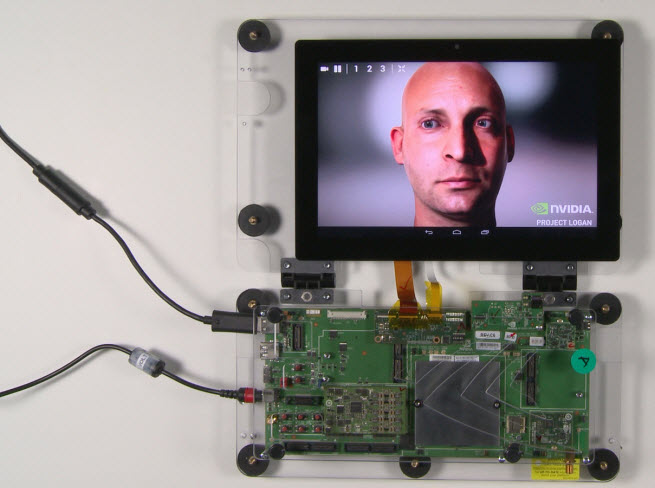Nvidia has been showing a stunning video of a computer-generated human face known as Ira. Now, the stunning fact is that the graphics chip maker will be able to fully animate that face on a mobile device using its next-generation mobile processor, Project Logan.
By the first half of 2014, Nvidia plans to launch Logan and bring together its long-separate mobile phone and desktop 3D graphics architectures. Logan is based on Kepler, the company’s most advanced graphics architecture that serves as the foundation for families of the company’s desktop and laptop chips. To date, Nvidia’s Tegra mobile processor-graphics chips have used a different architecture. But starting with Logan, the mobile processors will also use the power-efficient Kepler designs. It will make possible new mobile applications like better augmented reality, computer vision, and speech recognition.
“I think this is the biggest breakthrough in graphics since we introduced the GeForce 256 (graphics chip) 14 years ago,” said Dan Vivoli, senior vice president of corporate and strategic marketing at Nvidia in Santa Clara, Calif., in an interview with GamesBeat. “But this is 400 times more powerful than the original GeForce. This is the most efficient mobile processor ever designed.”
It is, in fact, 140 times more powerful than the first Cray supercomputer, or 1.6 times more powerful than a PlayStation 3. Vivoli said that the mobile version of Kepler will advance mobile computing by more than seven years, based on what is in the market today. With 192 graphics cores, or processors, Logan has several times more processors than the fastest Tegra 4 mobile chip that the company currently makes. But the number of cores is less than half of what Nvidia has on its laptop chips. Like Tegra, Logan will come with its own ARM-based processor attached to the graphics.
The revolutionary part is that Logan will deliver hyper-realistic graphics, like the Ira demo, on only two to three watts of power. That’s well within the envelope for mobile devices such as tablets and some smartphones too. Vivoli shows that it is possible to balance the often competing demands of performance and power efficiency. Performance per watt will be three times better than that of an Apple iPad 4, Vivoli said. Starting next year, Kepler will span every Nvidia product family from chips for everything from mobile to supercomputers.
Nvidia took the wraps off of Logan yesterday in a sneak peek at the Siggraph computer graphics conference in Anaheim, Calif. Nvidia’s new graphics part will have full support for OpenGL 4.4, OpenGL ES 3.0, DX11, CUDA 5, and OpenCL. That means that it will pretty much do full-spectrum of tasks that high-end computer graphics require on either PCs or a variety of other platforms.
Nvidia’s first Logan prototype chips have been back from the factories for only a few weeks, but the company says they are running cool demos such as Ira already. The Ira demo, which Nvidia introduced earlier this year to show off the powers of Kepler, is a realistic digital model of a human head generated in real-time. Faces are notoriously hard to make look realistic, but the Nvidia demo is one of the closest things to realism that you’ll find.
Vivoli said that the GeForce 256 graphics chip of 1999 was a huge milestone for the PC because it kicked off the graphics processing unit category, where a graphics chip could be programmed to do custom effects. With CUDA enabled on Logan, the mobile graphics chip will now be fully programmable, allowing the devices to handle many other kinds of tasks beyond graphics.
Kepler-based products began rolling out more than a year ago from Nvidia. Those chips, as well as Logan, feature lots of graphics cores such as tessellation, which creates geometric shapes dynamically and efficiently on the GPU based on high-level descriptions. It can also do anti-aliasing and post-processing algorithms, which can make 3D images look smooth and movie-like. And it can handle physics and simulations tasks that are normally handled by microprocessors. That will enable Logan to handle tasks such as computational imaging, computer vision, augmented reality, and speech recognition.
Nvidia said that Logan uses less than a third of the power of GPUs in leading tablets, such as Apple’s iPad, while performing the same rendering tasks. That means that Nvidia will have lots of headroom to scale up the device to more performance or better power efficiency.
Nvidia showed the chip running on Epic Games’ Unreal Engine 4 graphics software. Tim Sweeney, chief executive of Epic and one of the biggest names in computer graphics, said in a post, “More than ever before, we see the opportunity for developers to create high-end games and ship them across multiple platforms on a wide variety of devices, including tablet, smartphone, Windows, Mac, PlayStation 4, and Xbox One. Nvidia’s OpenGL 4.3 achievements open up the mobile front of this strategy.”
Dubbed “Ira to go,” Nvidia created the demo in concert with the Institute for Creative Technology at the University of Southern California. Ira smiles or grimaces and you’ll see his skin wrinkle. The lighting and shadows change as the point of view shifts. There’s a slight redness around the edges of his eyes where the eye meets the eyelid. And light bounces off the iris of Ira’s eyes in a realistic way.
Vivoli said that the convergence into a single architecture will be a big deal for Nvidia, which will no longer have the inefficiency of designing two completely separate families of chips.
“We have wanted to get a roadmap for high-end graphics and mobile to converge for a long time,” he said. “It wasn’t until the scalability of Kepler, the manufacturing process, and its power efficiency all came together that we could do it.”
You can imagine that one day Nvidia’s Shield mobile handheld gaming device will one day use this technology. Shield’s first version ships on July 31 for $299.
Here’s a video demo of mobile Ira below and a video of Project Logan below it.
VentureBeat's mission is to be a digital town square for technical decision-makers to gain knowledge about transformative enterprise technology and transact. Learn More



